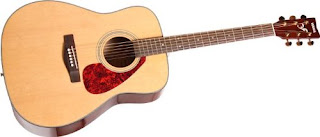If you're the type of acoustic guitarist that wants the most bang for your buck as you can get, then the Epiphone DR-100 definitely is a better deal than the Fender Starcaster for the beginner price range of acoustic guitars.
The Fender Starcaster costs 25% more than the Epiphone DR-100 and truly fails to deliver the quality that Epiphone provides with the DR-100, which is not surprising since Epiphone has been in the acoustic guitar business for many decades longer than Fender has.
Click here now and check out the
full review of the Epiphone DR-100 acoustic guitar. Don't waste your money on anything else in this price range or you'll regret it for the rest of your music career.
Epiphone DR-100: Best Build Quality and Design
Wood Quality
Epiphone DR-100
The Epiphone DR-100 uses mahogany for the neck, back and sides, A solid spruce top, and a rosewood fretboard. These woods are all well known and desired for their warm tonal qualities. The mahogany in particular makes this acoustic guitar stand out because it is a very dense wood so the string vibrations travel down the neck much easier which creates a lot volume.
Fender Starcaster
The Fender Starcaster is built with a laminated spruce top, agathis back, sides, neck, and a rosewood fretboard. Agathis is a popular wood for inexpensive acoustic guitars because it is lightweight and still pretty durable.
Neck Action
Epiphone DR-100
The Epiphone DR-100 is a particular standout among inexpensive guitars like the Fender Starcaster because these guitars are known for having higher actions than what is typically desired. Epiphone pre-adjusts the dual action truss rod before the DR-100 leaves the factory to ensure a comfortable string action height.
Fender Starcaster
The Fender Starcaster's string action is known to be a little high, which can be uncomfortable if you haven't yet developed a lot of finger strength. A cheap and easy fix for this would be to buy yourself a pack of lighter gauge strings or to learn how to adjust the truss rod in the neck of the guitar yourself.
Tuning Reliability
Epiphone DR-100
The Epiphone DR-100 scores another win here which isn't too surprising to me since I happen to know a little bit about Epiphone acoustics in general. Epiphone uses a special design that has the headstock bent from the neck at a 14 degree angle. This is done to increase pressure to the nut of the guitar instead of on the tuning machines. This really helps to keep your guitar in tune and keep you from wasting your time tuning it instead of practicing.
Fender Starcaster
I do have to give the Starcaster some credit here because this is the category that it performs the best in compared to the Epiphone DR-100. The Starcaster does stay in tune fairly well, but the Epiphone DR-100 definitely has it beat here, even it not by a lot.
My Final Verdit: Epiphone DR-100 vs Fender Starcaster

The Epiphone DR-100 is the clear victor here, since it costs less, its made of higher quality materials, has a much smoother action, and stays in tune better than the Fender Starcaster. The Starcaster is a good example of where you're paying more for the Fender brand name than the quality of the guitar itself. Not saying the Starcaster is a completely horrible acoustic guitar, I just find the Epiphone DR-100 to be a much more solid deal.
If happen to prefer the
Fender Starcaster acoustic guitar, click here for a more in-depth review of it.





